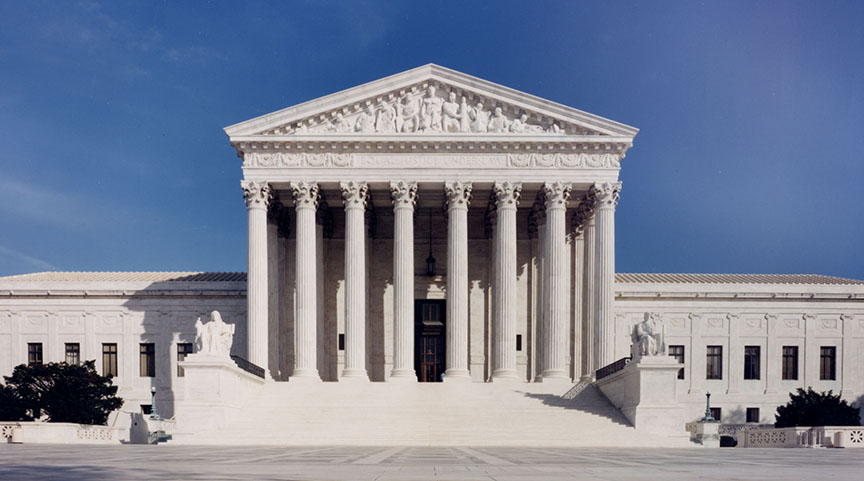Back in 2018, Michael Lewis, the author of Moneyball, wrote a masterful little book titled The Fifth Risk, about the dangers that can come from willful ignorance of how government agencies function, and from active mismanagement of their affairs. Lewis frames his book around the Trump presidential transition and his first year in office, a time that exemplified those two dangers to a previously unimagined degree. The book is a paean to the hard work and professionalism of the unseen ranks of federal employees that keep the US government running efficiently – what Trump disdainfully calls the “deep state.”
A Trump victory in November would, in service to an extremist right-wing political agenda, decimate agency expertise a second time. But in fact, Trump and his cronies in the arch-conservative movement have made progress toward this goal even without reoccupying the White House. The Supreme Court, with three Trump-appointed judges cementing a 6-3 conservative majority, is already laying anti-agency groundwork for his second term. It is important for healthy climate advocates to understand what the Court is doing, because its crippling of federal agency powers in a recent string of decisions threatens the ability of the US to meet its climate targets under the 2015 UN Paris Agreement.
The Supreme Court’s attack on the powers of federal agencies began two years ago with its decision in West Virginia v. EPA. The Environmental Protection Agency, acting under the authority assigned to it by Congress under the Clean Air Act, wrote regulations that would have sharply reduced CO2 and other greenhouse gas emissions from electric power plants. West Virginia, together with allied states and private companies in the fossil fuel industry, then sued the agency and won on the theory that the Clean Air Act does not authorize EPA to do that.
Now, the EPA exists in the first place because Congress, knowing that it lacks the time and expertise to get involved in the technical details of pollution control, created it to do that work. Carbon dioxide and some of the other greenhouse gases were not explicitly mentioned in the Clean Air Act, but in 2007 a friendlier Court ruled, in the famous Massachusetts v. EPA case, that carbon dioxide and other greenhouse gases are also within the scope the law. Four justices, including Justices Roberts, Alito and Thomas from the present court, tried to argue that CO2 is (somehow) not a pollutant, but did not prevail. That decision still stands. Following it, the West Virginia vs EPA majority approved one aspect of the new EPA rules, requiring existing coal and gas-fired power plants to operate more efficiently. CO2 emissions from the electric power sector will modestly decrease because more efficient coal and gas plants will generate the same amount of power from less fossil fuel.
Of course, a modest reduction in CO2 emissions comes nowhere near what is needed to mitigate the harm caused by global warming pollution. So the EPA also wrote much more far-reaching regulations, requiring the eventual substitution of coal and natural gas-fired power plants with electricity generation from sources that do not emit greenhouse gases, such as nuclear fission, geothermal heat, hydroelectric dams, wind farms and solar arrays.
In West Virginia v. EPA, the Court ruled that regulations requiring such “generation shifting” are beyond the legal authority bestowed by Congress. Yet in the Clean Air Act, the lawmakers said nothing about such agency limits. Rather, a reasonable reading of the law clearly suggests that the EPA is empowered to do what is necessary to solve the pollution problem. Faced with this dilemma, the Court simply made up a new canon of legal construction called the “major questions doctrine.” According to this legal principle, agency actions that would have major national significance must be supported by clear, specific authority from Congress. Here is the argument: global warming was not yet widely known as a problem when the Clean Air Act was passed in 1970, so the statute does not mention it. It is therefore not appropriate to use that law to authorize a significant transformation of the energy industry, even though CO2 has since been added as a regulated pollutant. Because of the major questions doctrine, the only way to implement the rejected regulations is for Congress to amend the Clean Air Act, unambiguously authorizing EPA to do what it takes to reduce the atmospheric levels of greenhouse gases.
As Justice Kagan’s dissenting opinion makes very clear, a different Court would have had no trouble concluding that the Clean Air Act we already have perfectly well authorizes the regulations rejected here. The language of the Act was intentionally broad, covering “any air pollutant,” not just the ones recognized at the time the Act was passed. But the majority was able to reject this obvious interpretation by inventing and then giving more force to a legal theory that, while sounding reasonable on its surface, also just happens to perpetuate the dominance of fossil fuels. This is one goal of the far-right Federalist Society, which delivered a list of acceptable Supreme Court nominees to Trump upon each vacancy that he had the chance to fill. The ex-President complied with their wishes, every time.
The decision in West Virginia v. EPA is already enough to make a big dent in the Clean Air Act as a vehicle to curtail global warming pollution. But it is at least limited to that law alone. This term, the Court went far beyond that ruling to deal a severe blow not only to EPA, but to all federal agencies. With its decision last week in Loper Bright Enterprises v. Raimondo, the Supreme Court overturned its 1984 Chevron v. NRDC decision holding that courts must defer to agencies in cases where the underlying law is ambiguous – as long as the regulations that the agency writes are based on a reasonable interpretation of the statute.
Loper Bright Enterprises was a trivial dispute of interest only to the fishing industry, but the Supreme Court accepted the case because it provided a good legal vehicle to invalidate Chevron. In fact, the far-right network of legal think tanks led by the Federalist society saw the case’s potential and shepherded it to the Supreme Court’s docket solely to promote the antiregulatory agenda that it shares with the conservative justices (see Earthward: 28 Sept. 2023, for further details about the case).
As in West Virginia v. EPA, the conservative majority’s ideological agenda was well in evidence here. In fact, their only argument is the following: Chevron must be overruled because a section of the 1946 Administrative Procedures Act states that the reviewing court must decide all questions of law and determine the meaning of what an agency decides to do. Fine, but as the dissent points out, the APA says nothing about the standard of review that a court must apply. Should it defer to the agency – as has been the consistent practice since the 1984 Chevron decision? Or should it take matters into its own hands, carrying out what is known as de novo review? Loper Bright Enterprises now says that all review of agency decisions must be de novo review. The only agency input to be allowed is a weak tea known as Skidmore deference, by which the agency is regarded as source of experience and judgment that the Court might – or might not – draw upon. Chevron is overruled in all federal courts, though state courts are still free to apply it.
Loper Bright Enterprises is also a particularly galling example of the conservative majority’s disrespect for the precedent set by past Supreme Courts – the principle of stare decisis, which holds that past decisions that have shaped the legal landscape over long periods of time, and engendered significant reliance, should not be overturned without very compelling reasons. Chevron v. NRDC is certainly significant; indeed, it is probably the single most influential administrative law decision that the Supreme Court has ever handed down. For 38 years after the APA was passed (from 1946 to 1984), no argument was made that, somehow, the section that the conservatives now rely on completely excluded the deferential standard that the unanimous Chevron majority held was perfectly consistent with that law. In view of this history, and the weakness of the majority’s legal argument, it is impossible to see Loper Bright Enterprises as anything but a judicial power grab sustained by the thinnest of logic.
What consequences can we expect from the death of Chevron? Most obviously, in our new legal landscape, decisions about contested regulations will be made by judges who no longer need be bound by the scientific expertise of the agencies. Some judges will, of course, still give agency regulations the benefit of the doubt because they know that they are written by teams of legal and scientific experts who base their decisions on exhaustive analysis of the technical literature. As Michael Lewis describes in The Fifth Risk, agencies are mainly populated by professionals who are genuinely dedicated to public service and the overarching mission of what they are there to do. They are the premier repositories of competence in government and the most important bulwark ensuring that policies are grounded in hard facts. Little wonder, then, that they come under attack by those who would benefit from public ignorance of science. Little wonder that Trump ordered the dismantling of many agency informational websites as a high priority when he took office.
Loper Bright Enterprises opens the door to what many experts are predicting will be a flood of lawsuits challenging regulations under the new standards. Two other decisions this term, Corner Post v. Board of Governors of the Federal Reserve System, and Securities and Exchange Commission v. Jarkesy, will add to this flood by extending the statute of limitations for old rules (Corner Post) and by requiring that some in-agency tribunals be replaced by proceedings in federal courts (SEC). Together, the three cases threaten to upend regulation-based actions across a wide array of issues relevant to the renewable energy transition. For example, the Federal Energy Regulatory Commission issues rulings that control development of the national electricity grid, and the Bureau of Ocean Energy Management writes regulations about offshore wind farms. We can be sure that those profiting from the fossil fuel economy will do all they can to bring regulatory cases before ideological judges who need no longer defer to agency experts.
If there is a silver lining to be found in any of this, it can only be a renewed recognition that Congress has the power to amend legislation to restore the status quo. This is particularly clear with respect to the Clean Air Act, which could certainly be expanded to include a new mandate to protect the public against pollutants that cause global heating. The Chevron decision may be harder to fix legislatively, because the justices can fall back on the 1803 Marbury v. Madison decision, establishing that it is “…emphatically the province and duty of the judicial department to say what the law is.” But even here there is a remedy, if Democrats are willing to seize it: when they again control both houses of Congress and the Presidency, pass Senator Elizabeth Warren’s bill to expand the size of the Supreme Court. And then take a page from the right wing playbook, and get these decisions reversed.
______________________
The Fifth Risk: https://wwnorton.com/books/The-Fifth-Risk/
Joe Klein’s review of The Fifth Risk: https://www.nytimes.com/2018/10/08/books/review/michael-lewis-fifth-risk.html
West Virginia v. EPA: https://www.supremecourt.gov/opinions/21pdf/20-1530_n758.pdf
Major questions doctrine: https://crsreports.congress.gov/product/pdf/IF/IF12077
Loper Bright Enterprises v. Raimondo decision: https://www.supremecourt.gov/opinions/23pdf/22-451_7m58.pdf
Federalist Society: https://www.washingtonpost.com/graphics/2019/investigations/leonard-leo-federalists-society-courts/?utm_term=.1d2008ed2d75
Chevron v. NRDC: https://supreme.justia.com/cases/federal/us/467/837/#tab-opinion-1955635
Corner Post: https://www.supremecourt.gov/opinions/23pdf/22-1008_1b82.pdf
SEC v Jarkesy: https://www.supremecourt.gov/opinions/23pdf/22-859_1924.pdf
Implications of Chevron’s demise for climate policy: https://insideclimatenews.org/news/28062024/supreme-court-overturns-chevron-doctrine/
Supreme Court expansion bill: https://www.warren.senate.gov/newsroom/press-releases/in-op-ed-senator-warren-calls-for-supreme-court-expansion-to-protect-democracy-and-restore-independent-judiciary#:

